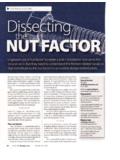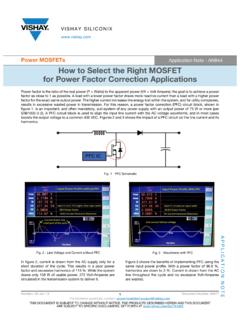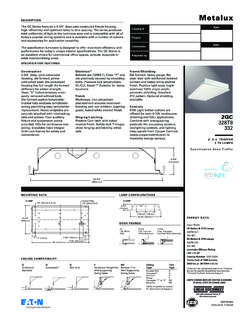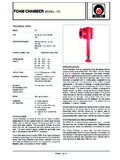Transcription of Condition Factor, K, for Salmonid Fish - …
1 March 1998. Condition Factor, K, for Salmonid Fish FN0005. Charles Barnham PSM & Alan Baxter ISSN 1440-2254. Anglers frequently refer to fish they have caught as being totally or partly dependent on stocking, the stocking rate in poor, good or excellent Condition . This qualitative can be reduced accordingly until the K value improves and reaches an acceptable level. measure is usually based on a visual assessment of the Amongst its operational requirements and responsibilities, fish, taking into account the general shape of the fish, its the Department is required to develop and maintain par- length and weight, and its appearance (which usually ticular standards.)
2 On the basis of comparison of the K value equates to how fat the fish is) compared to memories of with general appearance, fat content, etc, the following previous catches - this fish is in good Condition and is standards have been adopted by the Department for trout and salmon: better/worse than the one I caught yesterday' . Is this a fact, or a guess? K value Comments Excellent Condition , trophy class fish. Brown trout, Salmo trutta, rainbow trout, Oncorhynchus mykiss and chinook salmon, O. tshawytscha are commonly A good, well proportioned fish.
3 Subjected to this judgement. Improving the Condition of A fair fish, acceptable to many anglers. these fish and their populations is an integral part of the A poor fish, long and thin. Department's management objectives for fisheries where populations are totally or largely managed by stocking with Extremely poor fish, resembling a barracouta;. hatchery-produced fish. big head and narrow, thin body. In 1902, Fulton proposed the use of a mathematical formula The "K Chart" later in this NOTE indicates the relationship that would quantify the Condition of fish: between Salmonid length and weight.
4 It can be used within 10NW the limitations of the scales on the chart to assess the K = ---------- approximate K value of Salmonid fish and compare the L3 value with the Department's standard above. Examples of where: the range of K values are also illustrated. K is the Condition Factor or Coefficient of Con- dition; often simply referred to as the "K factor". How to calculate K. W is the weight of the fish in grams (g). As an example, take two trout, both 500 mm long, one fish L is the length of the fish in millimetres (mm). In weighing 1,000 g, the other 2,000 g.
5 The case of salmonids, length is measured from Trout 1: Trout 2: the tip of the snout to the rear edge of the fork at the centre of the tail fin; known as length to 105 x 1 000 105 x 2 000. caudal fork (LCF). The cube of the length is used K= K=. because growth in weight of salmonids is propor- (500)3 (500)3. tional to growth in volume. K of Trout 1 is , K of Trout 2 is , N = 5; having weighed and measured thousands of sal- a very poor specimen. an excellent specimen. monids from Victorian waters, the value of N. used by the Department for determining K is set at this figure to bring the value of K close to Summary unity.
6 For salmonids, K values usually fall in the The Condition Factor K allows the Department to compare range to quantitatively the Condition of individual fish within a population, individual fish from different populations, and The value of K is influenced by age of fish, sex, season, two or more populations from different localities. stage of maturation, fullness of gut, type of food consumed, amount of fat reserve and degree of muscular development. K may also be used as an index of the productivity of a In some fish species, the gonads may weigh up to 15% or water.
7 More of total body weight. With females, the K value will The K value is greatly influenced by the stage of develop- decrease rapidly when the eggs are shed. ment of the reproductive organs. Therefore, when compar- ing K values, it is important to sample the individuals or The K value can be used to assist in determining the populations at the same time of the year so that the indi- stocking rate of trout in a particular water. If the K value viduals or populations are at the same stage of the reproduc- reaches an unacceptably low level in a water which is tive cycle.
8 State of Victoria, Department of Primary Industries 2003 Page 1. Condition Factor, K, for Salmonid Fish FN0005. K Factor Calculation Chart Length (mm). 200 225 250 275 300 325 350 375 400 425 450 475 500 525 550 575 600. 100 125 Extremely Poor-Poor 150 175 Fair - Good 200 225 Excellent-Exceptional 250 275 300 325 350 375 400 425 450 475 500 600 700 800 900 1000 1 100 1 200 1 300 1 400 1 500 1 600 1 700 1 800 1 900 2 000 2 100 Weight 2 200 (g) 2 300 2 400 2 500 2 600 2 700 2 800 2 900 3 000 3 100 3 200 3 300 3 400 3 500 3 600 3 700 3 800 3 900 4 000 4 100 4 200 4 300 4 400 4 500 State of Victoria, Department of Primary Industries 2003 Page 2.
9 Condition Factor, K, for Salmonid Fish FN0005. EXTREMELY POOR POOR. Species: Brown trout Length: 505 mm Species: Brown trout Length: 435 mm Sex: Female Weight: 1 000 g Sex: Female Weight: 700 g Gonad stage: Ripe K Factor: Gonad stage: Ripe K Factor: Comment: Fish is long and thin with very little flesh. Comment: This fish is also long and thin. FAIR GOOD. Species: Brown trout Length: 400 mm Species: Brown trout Length: 400 mm Sex: Female Weight: 760 g Sex: Female Weight: 870 g Gonad stage: Mature K Factor: Gonad stage: Mature K Factor: EXCELLENT EXCEPTIONAL.
10 Species: Brown trout Length: 545 mm Species: Brown trout Length: 510 mm Sex: Female Weight: 2 680 g Sex: Female Weight: 2 680 g Gonad stage: Ripe K Factor: Gonad stage: Ripe K Factor: Reference Fulton, T. (1902) Rate of growth of seas fishes. Sci. Invest. Fish. Div. Scot. Rept. 20. Concept and Design: Charles Barnham Photographs: Alan Baxter Image scanning: John Elliott This publication may be of assistance to you but the State of Victoria and its officers do not guarantee that the publication is without flaw of any kind or is wholly appropriate for your particular purposes and therefore disclaims all liability for any error, loss or other consequence which may arise from you relying on any information in this publication.




